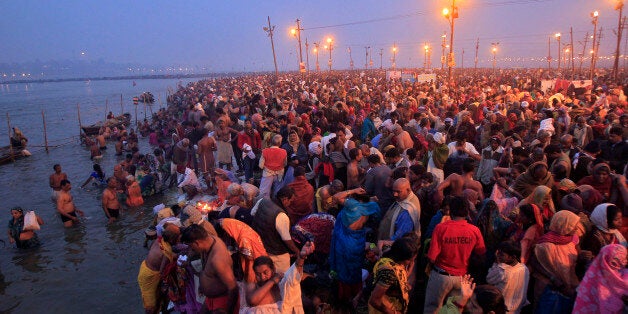
On a sultry evening in Varanasi, the spiritual capital of India, smoke from funeral pyres sweeps into a fading azure sky. Wisps of burnt orange float along the horizon where gods greet departed souls. I rush with Hindu pilgrims and other tourists like myself, toward the ritual prayer ceremony on a platform known as a ghat, overlooking the Ganges -- the most-worshipped and one of the most-polluted rivers in the world. When Prime Minister Modi was elected to power in 2014, he pledged to clean up the Ganges, but tension between religious tradition and scientific ecology makes this waterway's decontamination project every politician's and environmentalist's nightmare. Progress has been slow despite harsh fines imposed on fizzy drinks factories and leather curing plants. Toxic waste continues to spill into the river. Modern sewerage plants overflow as a result of frequent power cuts so that by the time this revered, defiled waterway has travelled 1,500 miles to the Indian Ocean it will have flowed past over 29 overcrowded cities, 70 squalid towns, and thousands of impoverished villages spewing sewage -- over 1.3 billion liters per day, along with animal carcasses and 260 million liters of industrial waste.
People pushing, bodies bumping, and I manage to squeeze in between strangers on a stone bench near a shrine on the bank. Boats decorated with candles and marigolds drift by. Men in loincloths vigorously soap their bodies, which are soon covered in white foam. Then, to wash away their sins, they hold their noses and dunk in the Ganges, as polystyrene cups and pieces of newspaper idle by. Not far away, women draped in magenta and lapis blue saris follow suit. They sink up to their shoulders into the khaki water alongside floating wooden planks, laden with cremated remains wrapped in saffron-colored fabric. Souls in transit.
Safe on terra firma, I hold my breath along with them. Immersion in the Ganges is deemed to rid worshippers of sin, not transmit water-borne diseases -- amoebic dysentery, cholera, hepatitis and typhoid. How many people get sick from this water and perhaps die?
I'd read that the Ganges was contaminated, but I didn't expect to see plastic bottles, pieces of cloth, condoms and tampons, bobbing unnoticed and unheeded -- weaving amidst the worshipers near the murky banks. Flotsam from pesticides and residues from chemical factories. I hadn't expected to smell the caustic effluents from the leather tanneries sulphuric acid and the stench from lime pits. Ammonia from raw sewage.
I try to focus on the two tall, imposing priests in kimono-like robes who step onto a small platform, but I'm distracted by a woman struggling to disentangle a plastic bag from her dripping hair. Then she pushes it away into the fetid current. Framed by the sinking sun, each priest lifts two lanterns, and waves his hands in large circles as if they were gods showing us the path to paradise. A sacred silence subdues the oppressive cacophony. The soft echo of a conch and the evening prayer rites begin.
Millions visit Mama Ganges every year to experience the deep spirituality that enshrouds those sacrosanct crossroads, where life and death embrace each other with so much openness. Varanasi, brimming with sanctuaries and hospices, is known as the best place to die and be cremated to achieve moksha -- liberation from the unending cycle of death and reincarnation. Over 200 open-air cremations are carried out daily. Some dead bodies -- children, snakebite victims and those in renunciation -- are exempted from cremation, bound with stones and immersed in the water. Mukhagni, (lighting of a fire in the deceased's mouth) and kapal kriya, (shattering of the skull by a blow from a stick to release the soul) are vital for moksha. Human remains, especially bones, must be submerged in the river so that the soul will not suffer.
An eco cremation -- where the wood sits on a metal tray with an overhanging exhaust hood -- is now available. This method uses a third as much wood and takes two hours instead of three days, but most families prefer to stick with the centuries-old religious rituals. Although these death rites are not the sole or even the biggest contaminator of the Ganges, they are undoubtedly a contributor.
Now I chant along with the priests willing them to help the endangered species -- the blind fresh water Ganga dolphins entangled in discarded fishermen's nets; the rare freshwater shark; and the unique marsh crocodiles. Would they encourage polluters to change their ways to save bar-headed geese, herons and Indian skimmers?
Through the practice of dharma, the path of righteousness, Hindus believe that they have a moral duty to protect the environment -- caring for animals, plants and the natural world. Could these holy men, inspire visitors and locals to become vigilant advocates of the river's future? Could they bring help back the birch trees and juniper bushes to the plains that have now become a desert? When the pollution conversation is shaped in this manner, people might realize that their actions go against their deepest values. This makes change possible.
Millions of dollars have already been spent on infrastructure projects and sewage systems, with minimal impact. It's time for Prime Minister Modi to bridge the gap between environmentalists, ecologists and religious traditions so that the Ganges itself can be reborn, be holy, and be whole again.
